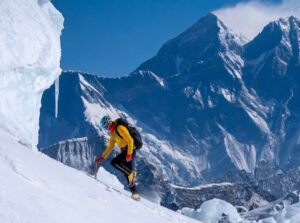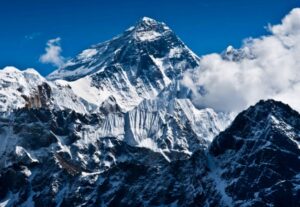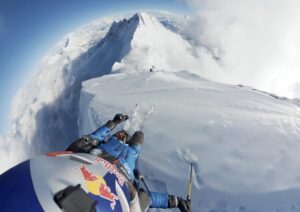Whether or not to turn around is one of the most difficult decisions a climber may have to make during a summit push. On Everest, sherpa guides will suggest how to proceed, but they hold no authority. What if climbers keep going until they cannot move any further, up or down? Should sherpas leave them behind and save themselves, or should they die together?
Jon Mills, one of this year’s Everest summiters, contacted us with the story of a man who took the second option. It raises serious issues about authority, managing clients, and an avoidable tragedy.
“I was the last person to see Cheruiyot Kirui and Nawang Sherpa alive on May 22, 2024, around 8:30 am, between the summit and the Hillary Step,” Mills began.
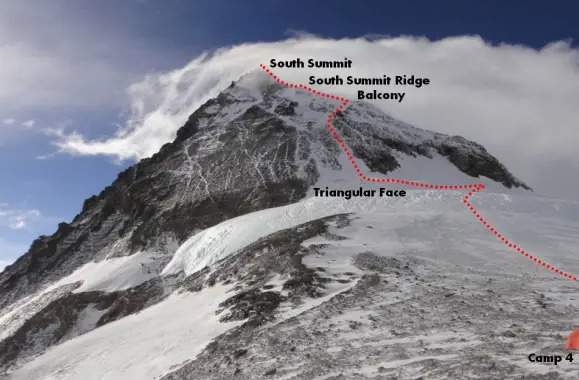
The upper part of the normal route on Everest. Photo and topo: Hip Hop Everest Expedition
Everest 2024 numbers
Gautam Khim Lal of the Ministry of Tourism, Culture, and Civil Aviation recently shared the 2024 spring Everest Report. It shows that 421 foreign climbers from 62 countries had a permit to attempt Everest. They were supported by 767 local high-altitude porters and guides. In the end, 758 individuals summited (including both clients and guides). This made an amazing 63.8% success rate. Finally, eight people died on Everest in the spring of 2024.
The victims included Cheruiyot Kirui and Nawang Sherpa. Kirui, a banker by profession, was a paying client from Kenya who wanted to climb Everest without supplemental oxygen. Nawang was a 44-year-old sherpa with Seven Summit Treks, the outfitter servicing Kirui’s expedition.
What happened on May 22 at the Hillary Step?
Jon Mills climbed with Adventure Peaks, using oxygen and supported by Furinji Sherpa. He told ExplorersWeb that he was slow on his summit day until the Balcony because of issues with the regulator on his O2 system. Once that was sorted out, he and Furinji continued to the top.
Meanwhile, most teams, including the rest of Mills’ group, were already on their way down. If Mills passed Kirui and Nawang on the way up, he didn’t notice. Mills reached the summit on May 22 at around 8 am. No one else joined them there or passed them on the way down.
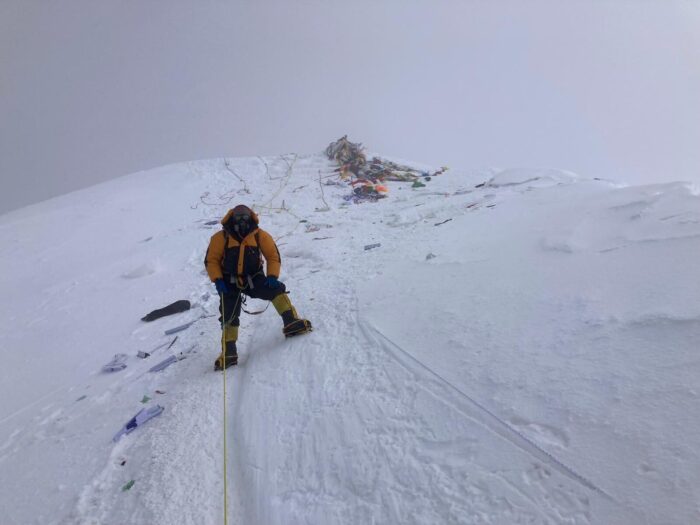
Furinji Sherpa waits for Mills right before the summit of Everest while the British climber changed his oxygen cylinder. Each carried three bottles. Photo: Jon Mills
They had the summit to themselves. The weather had been great until just before the top, but now visibility was dropping, and winds had started to build. As they started their descent, they found Kirui and Nawang on the trail between the summit and the Hillary Step.
A grisly scene
Kirui was upside-down and groaning, gloves off, hood down, suit open. Nawang sat next to him, eyes open but completely unresponsive, as if in a trance.
“I yelled in Nawang’s face, trying to get a reaction,” said Mills. “There was none. I got Kirui the right way round — and so I am sure that he was attached to the ropes — and I zipped him up. Thankfully, he stopped the awful groaning then, and at least he didn’t seem to be distressed anymore.”
Mills made an SOS call to his team, but only the Base Camp staff responded.
“It was a broken transmission, but we got the gist across,” Mills noted. The weather continued to change rapidly, with winds building fast. “With no shelter, no sleeping bags, no warm fluids, and a limited supply of oxygen, there was nothing further that we could do,” explained Mills. “I looked at Furinji in desperation, and he quietly shook his head. I reluctantly nodded. If we had stayed, it would have been four dying men, not two.”
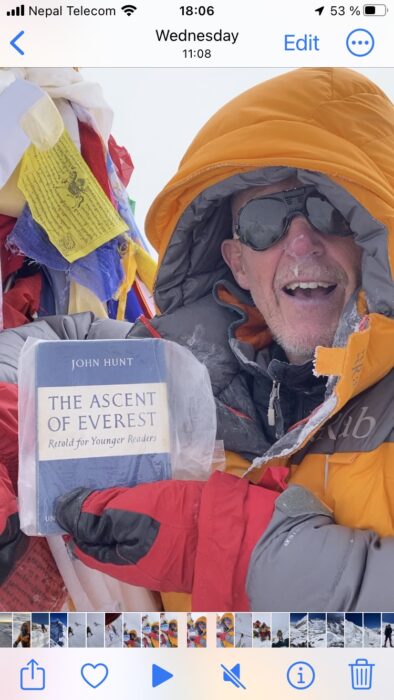
Jon Mills on the summit of Everest, May 22, 2024. Photo: Furinji Sherpa
They left, and Mills has been racking his brain about whether there could have been something more they might have done if they had intercepted the other pair just a little earlier. Perhaps, he wonders, if they had been able to get Nawang back on his feet and help him to the ropes at the South Summit, they might have been able to lower him down from there…
At around the Balcony, Furinji was getting cold, and Mills sent him ahead. He was slower but feeling well and confident, and he was worried for his companion.
“No one passed me coming up, and I was definitely the last person down,” he said. “I was exhausted but still functioning when I got to the South Col.”
Hours of abnormal behavior
Back in Base Camp, Mills reported what he had witnessed. He was told that the problems with Kirui had started earlier.
Mills says that on May 26-27, “Seven Summit Treks’ Base Camp staff told me that Nawang had been reporting on the radio that for two to three hours, Kirui was behaving irrationally and ignoring his advice and pushing him away.”
Indeed, Seven Summit Treks told The Himalayan Times: “Nawang last communicated with Base Camp officials from Bishop Rock [a feature close to the summit] that Kirui refused to return or even consume bottled oxygen but showed abnormal behavior.”
A history of HAPE
Everest was not Kirui’s first no-O2 8,000m peak. He had previously climbed Manaslu, but the Kenyan had admitted on Facebook that he’d had two bouts of high-altitude pulmonary edema on that expedition. Before Manaslu, the highest Kirui had climbed was Kilimanjaro. Fitness-wise, he had run some ultra-marathons.
Kirui summited Manaslu together with James Muhia, both without O2, on Sept. 24, 2023. At the time, Kirui admitted, “Nothing much to report except that I’ve never felt slower in my life. Took us 14 hours from Camp 4 to summit.”
During his 2024 Everest expedition, he recalled his episode of HAPE on Manaslu.
Yet Kirui was extremely self-absorbed in his goal of climbing Everest without oxygen.
“I feel I can comfortably climb Everest with oxygen, which unfortunately neutralizes the thrill of such a climb for me,” he wrote on Instagram. “I’m not sure of my chances without oxygen, though, which makes such an attempt exciting.”
He also stated he hoped to become the first African to summit Everest without supplementary oxygen.
On his last Instagram post, written right before leaving on his ill-fated Everest summit push, Kirui noted that he was “susceptible to HAPE,” so he took nifedipine, dexamethasone, and acetazolamide with him. He also mentioned that Nawang was carrying an emergency bottle of oxygen to be used “if I go lights out or if I go bananas, if I’m time-barred, [in] unfavorable weather, or body limit reached: when I realize I’m no superman.”
Apparently, all of these factors occurred.
Incoherent reports
Kirui’s family told the Kenyan paper, The Star, “[As soon as Kirui] was reported missing by his expedition company, immediately a team of rescue sherpas stationed at Camp 4 was dispatched to the point of last contact.”
However, Mills questions whether the rescue was as fast as the family described.
“I was the last one down through the storm that morning, and I sent Furinji Sherpa on ahead faster because he was getting cold, and I was fine plodding down on my own,” he said. “I reached Camp 4 in the early afternoon. No one passed me coming up as I descended between the summit ridge and Camp 4.”
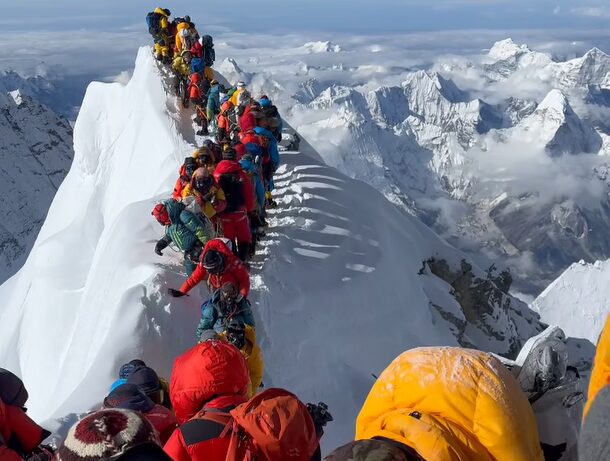
Traffic jam meters away from the summit of Everest on May 21. Footage: Vanayak Malla
Searchers soon found Kirui’s body, but as far as is known, Nawang’s remains have not been recovered. When asked about it, Mills said he was positive Kirui was clipped to the ropes, but he didn’t check whether Nawang was secured as well. He is not sure whether an unclipped Nawang simply slid away or whether he had had a lucid moment and had tried to move.
According to The Star, Kirui’s family was not aware of the details of the accident but told the paper, “Cheruiyot [Kirui]’s body was discovered at an altitude of 8,800m, 48 meters from the summit. While it is impossible to determine the exact sequence of events, we know that Cheruiyot and his sherpa took a fall.”
Mills strenuously disputes that a fall was the cause of the accident.
“I saw no evidence that either of them had taken a fall, and they will have had loads of people around them until just past the Hillary Step,” he explained. “I found the track from the Hillary Step to the summit to be the least challenging part of the whole day. It is only a gentle slope.”
Loyal to the death
“Rather,” Mills went on, “the situation that led to tragedy seems to have been a climber unable to act rationally, and a sherpa with no authority or means to force him to turn around, or even get him to accept help, and who fulfilled his duty to the last, with tragic consequences.”
Mills was told in Base Camp that after Nawang reported trying unsuccessfully to give Kirui the emergency oxygen, they asked him to just keep trying to convince him. Then they lost radio contact.
Here comes the key question: What was Nawang supposed to do? Leaving the client without permission from his bosses could have caused serious professional trouble for him, but he might still be alive to deal with it. The only other option was to stay and die with his client, which finally happened.
Mills believes Nawang, who led the climb, had a right to leave. “If Nawang’s professional advice was ignored, there was no point in him still being there and being at risk,” Mills said. “Ultimately, he died because he was unbelievably loyal, and I grieve for him and his family.”
A critical issue
The case highlights a critical issue on commercial expeditions. In recent years, as the number of climbers grows, so do their ambitions. Many want to set records, which are becoming harder to get, requiring them to push harder and risk more. Clients depend on their sherpa guides for every step they take, but they do not recognize their authority when the guides suggest that in the name of safety, they need to turn back.
The case is similar to the situation of Indian climbers Baljeet Kaur on Annapurna and Piyali Basak on Makalu last year. Both were determined to climb without oxygen and refused to turn around. Basak reportedly summited but collapsed during the descent, unable to move. She was rescued in serious condition.
Kaur needed 27 hours to reach the summit of Annapurna. By the time she did, she was sick with high-altitude cerebral edema and unable to make clear decisions. She also collapsed shortly after starting down. Her two accompanying sherpas eventually left her around 7,900m and returned to Camp 4. She was presumed dead. However, the Indian woman somehow survived and managed to send an SOS message through her InReach hours later, which prompted her rescue.
Everyone avoids the issue
These and similar events prove how complex rescue becomes if the client gets to the point of exhaustion or sickness. Many local climbers lack official accreditation as guides, weakening their authority. Unreasonable clients with no experience or skills fail to understand the risks they are taking. Agencies prefer to focus on success rather than emphasize to their clients what needs to happen if something goes wrong.
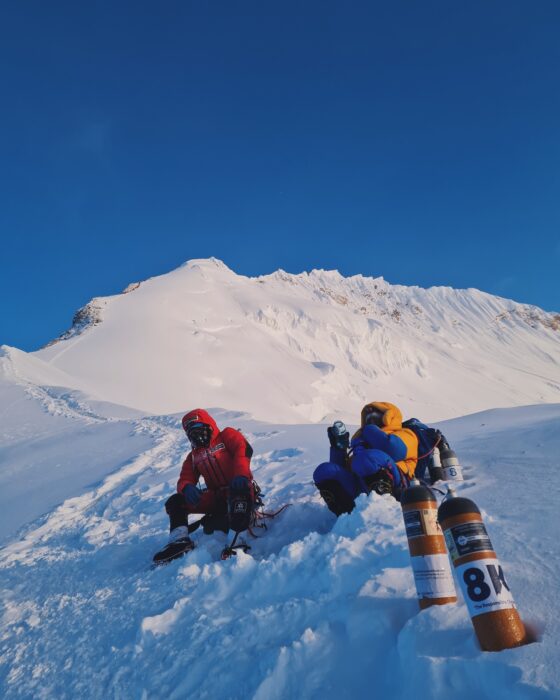
Climbers from 8K Expeditions near the South Summit of Everest, with the summit ridge behind. Photo: 8K Expeditions
This spring, only eight people died on Everest — a comparably light year — but every climber lost is tragic. Statistically, death on the 8,000’ers seems to take a higher toll on local workers. Many of these deaths could be avoided with clearer protocols, faster action from everyone involved, and a better-informed approach from the paying climbers. Not only their lives but also the lives of others depend on it.
Epilogue: The second death of Nawang Sherpa
News of Cheruiyot Kirui’s demise spread around the world within hours. His body was recovered on May 23. However, Nawang’s body was not. He was simply reported missing, then further news buried his memory. We have not even been able to find pictures of him to illustrate this story or details about his life and climbs.
Back home after Everest, Jon Mills contacted some media in the UK about the story of Nawang, but no one seemed interested. “I don’t care for [a story about] sherpas,” the editor of a major magazine told him.
Silence and oblivion seem like a sort of second death for Nawang Sherpa. We would appreciate the help of readers of this story if they could share images or information about him in the Comments section.
As for Mills, he has not given up on honoring the memory of Nawang Sherpa. Some weeks ago, he wrote a letter to the British government, nominating the loyal sherpa for the George Cross, an honor granted to Commonwealth citizens for acts of the greatest heroism or of the most conspicuous courage in extreme danger.


